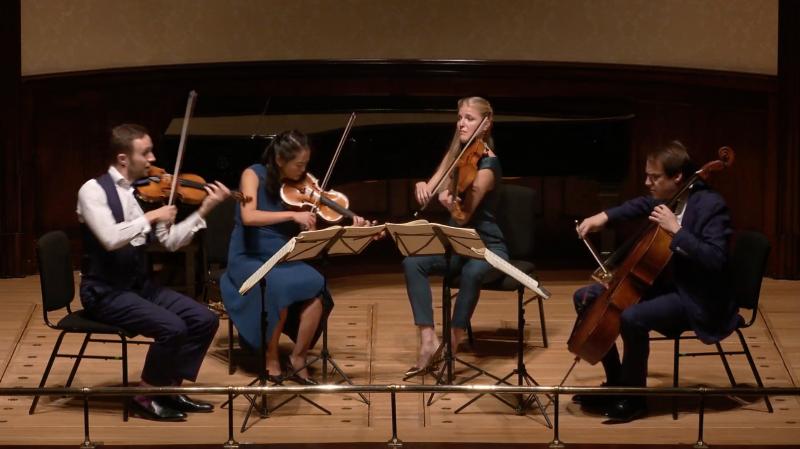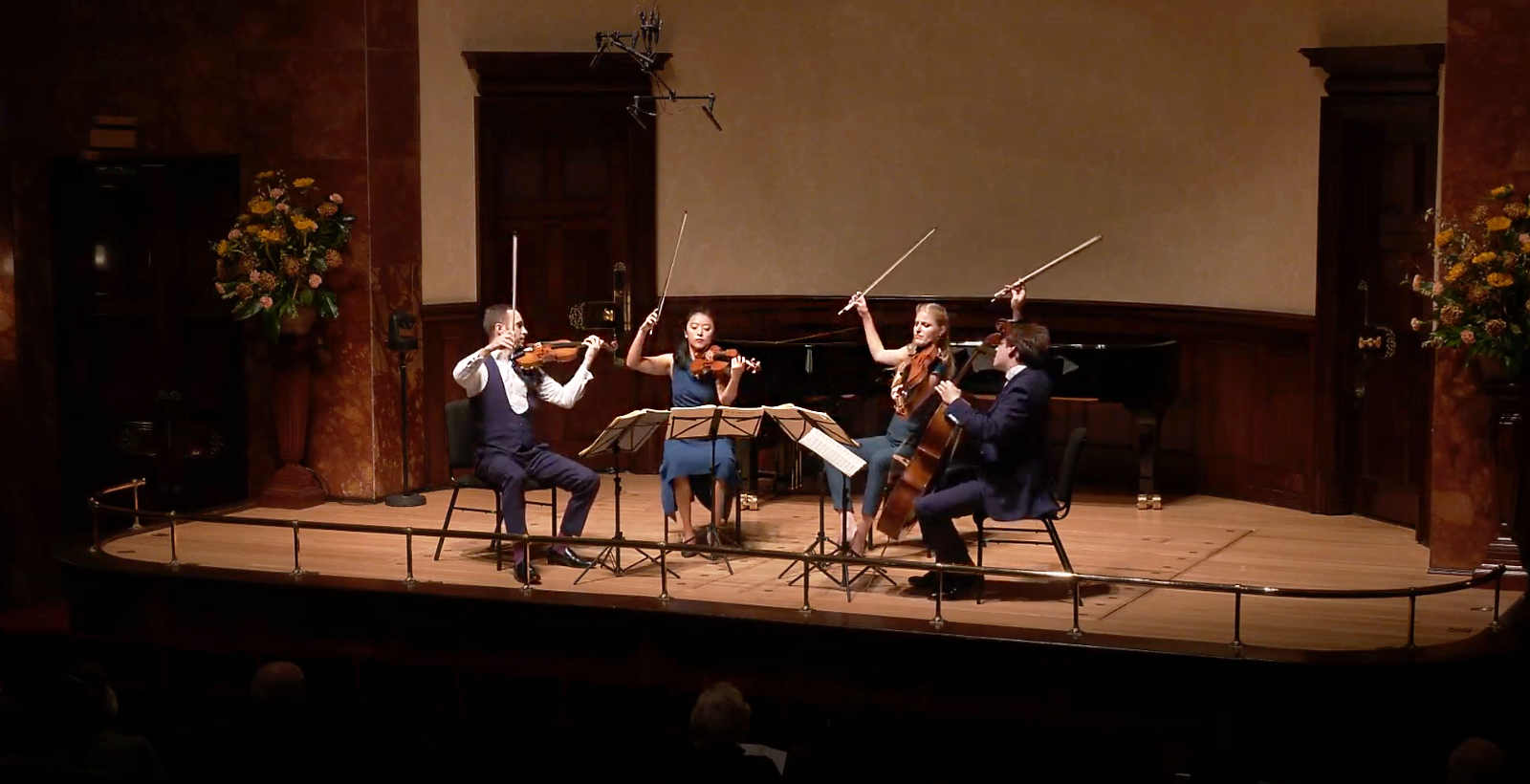Doric Quartet, Wigmore Hall review – sombre reflections | reviews, news & interviews
Doric Quartet, Wigmore Hall review – sombre reflections
Doric Quartet, Wigmore Hall review – sombre reflections
Late quartets of Mozart and Britten delivered with gentle but sustained intensity

With the wealth of online performances during the pandemic, it is easy to forget the regular offerings from the Wigmore Hall. The Hall found itself in a better position than most, as it was able to present its autumn schedule largely unchanged, the only programming issues arising from international travel limitations for the performers.
The Doric Quartet performed two works by Mozart and Britten connected by clear but subtle connections. Both were among the respective composer’s final works. That is little more than an accident of history in the case of Mozart’s first “Prussian” String Quartet, K 575, but Britten’s Third Quartet is much more retrospective and elegiac. Also, K 575 has a nickname, “The Violet”, coined by the musicologist Hans Keller, to whom Britten’s quartet is dedicated. So the programme tied together quite nicely.
The quartet has a distinctive sound, which suits the two works, but in different ways. The tone isn’t round or warm, more sinewy and focussed. In louder passages, this grows in body to an impressively dramatic sound, but always with that focus of line and clarity of texture. First violin Alex Redington defines the ensemble with his precise and often steely tone production. Cellist John Myerscough also plays an important role. His sound is muscular, anchoring the quartet’s tone, but also often standing out from the other players. He can blend with ensemble too, but usually though violist Hélène Clément increasing the weight of her sound to match him.  The Mozart was played with Classical-era bows, but these looked very similar to the modern standard and any difference in tone was too subtle for my ear. If the aim was a lighter texture, it didn’t really succeed, but that didn’t matter, as the Doric’s muscular intonation proved a good match for Mozart’s often emphatic textures. The players also bring lightness and bounce through their brisk and often capricious tempos. In the first movement, they often sped into statements of the themes, only restoring the main tempo and the last possible moment. A similar nervous energy characterised the second movement Andante, with thematic statements teasingly hesitant, and delicate interplay between the instruments. The third movement Minuetto was given a weighty reading, with brutal accents and emphatic phrasing. The finale was again weighty, but balanced by the playful interludes.
The Mozart was played with Classical-era bows, but these looked very similar to the modern standard and any difference in tone was too subtle for my ear. If the aim was a lighter texture, it didn’t really succeed, but that didn’t matter, as the Doric’s muscular intonation proved a good match for Mozart’s often emphatic textures. The players also bring lightness and bounce through their brisk and often capricious tempos. In the first movement, they often sped into statements of the themes, only restoring the main tempo and the last possible moment. A similar nervous energy characterised the second movement Andante, with thematic statements teasingly hesitant, and delicate interplay between the instruments. The third movement Minuetto was given a weighty reading, with brutal accents and emphatic phrasing. The finale was again weighty, but balanced by the playful interludes.
Britten’s Third Quartet is a darker and more sombre work. It was written during the composer’s final illness, most of it in Aldeburgh, but the last movement in Venice, the music here quoting his opera Death in Venice written a few years before. The Doric Quartet are closely associated with the work and have recorded it for Chandos. Their focussed tone is ideal for this music, and they often take the timbre to extremes. The first movement is called “Duets” and sets the players in pairs. In each, the woody tone of the two players was well matched. A sullen, muted lyricism hangs over this music, and the movement eventually evaporates into a series of highly ambiguous harmonics.
The slow middle movement was an exercise in sustained intensity. The players here applied little or no vibrato, instead carrying the long lines in simple pure tone. The Venice-inspired finale is another broad but subdued canvas. The themes are simple, but Britten never lets us get comfortable, and, despite the moderate dynamics, there is a muted intensity that continues into the ambiguous conclusion. The Doric Quartet judged the mood here perfectly, applying their angular tone to Britten’s increasingly sparse textures, and signing off the coda with a gentle intensity perfectly matched to the sense of resignation in Britten’s score.
rating
Explore topics
Share this article
The future of Arts Journalism
You can stop theartsdesk.com closing!
We urgently need financing to survive. Our fundraising drive has thus far raised £49,000 but we need to reach £100,000 or we will be forced to close. Please contribute here: https://gofund.me/c3f6033d
And if you can forward this information to anyone who might assist, we’d be grateful.

Subscribe to theartsdesk.com
Thank you for continuing to read our work on theartsdesk.com. For unlimited access to every article in its entirety, including our archive of more than 15,000 pieces, we're asking for £5 per month or £40 per year. We feel it's a very good deal, and hope you do too.
To take a subscription now simply click here.
And if you're looking for that extra gift for a friend or family member, why not treat them to a theartsdesk.com gift subscription?
more Classical music
 First Person: Manchester Camerata's Head of Artistic Planning Clara Marshall Cawley on questioning the status quo
Five days of free events with all sorts of audiences around Manchester starts tomorrow
First Person: Manchester Camerata's Head of Artistic Planning Clara Marshall Cawley on questioning the status quo
Five days of free events with all sorts of audiences around Manchester starts tomorrow
 Goldscheider, Brother Tree Sound, Kings Place review - music of hope from a young composer
Unusual combination of horn, strings and electronics makes for some intriguing listening
Goldscheider, Brother Tree Sound, Kings Place review - music of hope from a young composer
Unusual combination of horn, strings and electronics makes for some intriguing listening
 theartsdesk Q&A: composer Donghoon Shin on his new concerto for pianist Seong-Jin Cho
Classical music makes its debut at London's K-Music Festival
theartsdesk Q&A: composer Donghoon Shin on his new concerto for pianist Seong-Jin Cho
Classical music makes its debut at London's K-Music Festival
 Helleur-Simcock, Hallé, Wong, Bridgewater Hall, Manchester review - moving lyricism in Elgar’s concerto
Season opener brings lyrical beauty, crisp confidence and a proper Romantic wallow
Helleur-Simcock, Hallé, Wong, Bridgewater Hall, Manchester review - moving lyricism in Elgar’s concerto
Season opener brings lyrical beauty, crisp confidence and a proper Romantic wallow
 Kohout, Spence, Braun, Manchester Camerata, Huth, RNCM, Manchester review - joy, insight, imagination and unanimity
Celebration of the past with stars of the future at the Royal Northern College
Kohout, Spence, Braun, Manchester Camerata, Huth, RNCM, Manchester review - joy, insight, imagination and unanimity
Celebration of the past with stars of the future at the Royal Northern College
 Jansen, LSO, Pappano, Barbican review - profound and bracing emotional workouts
Great soloist, conductor and orchestra take Britten and Shostakovich to the edge
Jansen, LSO, Pappano, Barbican review - profound and bracing emotional workouts
Great soloist, conductor and orchestra take Britten and Shostakovich to the edge
 Jakub Hrůša and Friends in Concert, Royal Opera review - fleshcreep in two uneven halves
Bartók kept short, and a sprawling Dvořák choral ballad done as well as it could be
Jakub Hrůša and Friends in Concert, Royal Opera review - fleshcreep in two uneven halves
Bartók kept short, and a sprawling Dvořák choral ballad done as well as it could be
 Hadelich, BBC Philharmonic, Storgårds, Bridgewater Hall, Manchester review - youth, fate and pain
Prokofiev in the hands of a fine violinist has surely never sounded better
Hadelich, BBC Philharmonic, Storgårds, Bridgewater Hall, Manchester review - youth, fate and pain
Prokofiev in the hands of a fine violinist has surely never sounded better
 Monteverdi Choir, ORR, Heras-Casado, St Martin-in-the-Fields review - flames of joy and sorrow
First-rate soloists, choir and orchestra unite in a blazing Mozart Requiem
Monteverdi Choir, ORR, Heras-Casado, St Martin-in-the-Fields review - flames of joy and sorrow
First-rate soloists, choir and orchestra unite in a blazing Mozart Requiem
 Cho, LSO, Pappano, Barbican review - finely-focused stormy weather
Chameleonic Seong-Jin Cho is a match for the fine-tuning of the LSO’s Chief Conductor
Cho, LSO, Pappano, Barbican review - finely-focused stormy weather
Chameleonic Seong-Jin Cho is a match for the fine-tuning of the LSO’s Chief Conductor
 Classical CDs: Shrouds, silhouettes and superstition
Cello concertos, choral collections and a stunning tribute to a contemporary giant
Classical CDs: Shrouds, silhouettes and superstition
Cello concertos, choral collections and a stunning tribute to a contemporary giant
 Appl, Levickis, Wigmore Hall review - fun to the fore in cabaret and show songs
A relaxed evening of light-hearted fare, with the accordion offering unusual colours
Appl, Levickis, Wigmore Hall review - fun to the fore in cabaret and show songs
A relaxed evening of light-hearted fare, with the accordion offering unusual colours

Add comment